Jesse Ziegler | August 24, 2017
2018 Husqvarna TE250i First Test – The future of fuel-injected two-stroke dirt bikes is here. It’s alive. It’s well. And it works. And the first fuel-injected two-stroke to hit our home turf for testing is this 2018 Husqvarna TE250i.
In the past few weeks, I took the 2018 Husqvarna TE250i on an off-road road trip out of the southern California landscape of highway zombies and home school-infested MX tracks and into a more suitable home for which to twist the grip—the high alpine country of Idaho and Montana. After all, this is an enduro bike; why not take it to real enduro country?
So I did. I loaded up and shot north. I rode some great trail in some great parts of the country. In-between meetings and official Cycle News work business, I even managed to have some fun. And boy, is this bike fun.
And I didn’t have to bring a gas can full of premix.
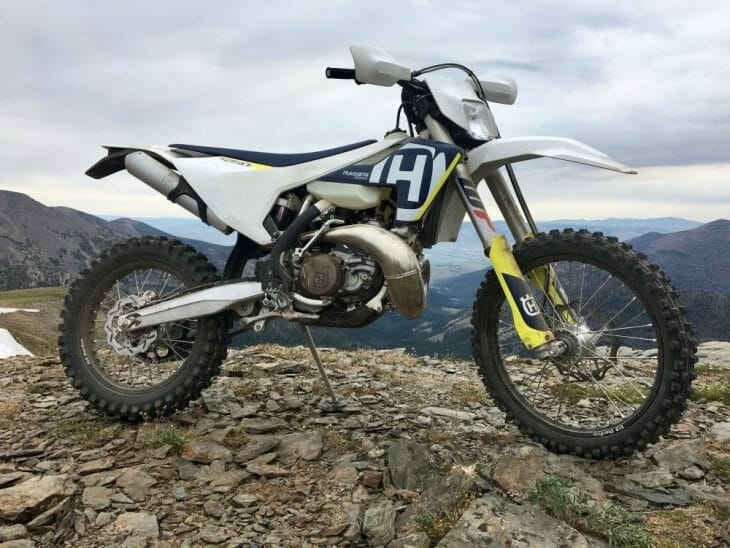
How does the 2018 Husqvarna TE250i work?
This bike gets a lot of attention in the enduro world. For riders I met on the trail to dirt bike-loving locals in the smallest of towns we rode through, the lowercase “i” on the graphics is like a tractor beam—drawing them in to see what’s going on with this computer driven gas and oil business.
Along with the attention, came a lot of questions. And they’re always the same. I’ll now try to answer them in the order they are asked every time I talk to someone about the bike.
How’s the power on the fuel-injected Husqvarna two-stroke?
It’s really cool to ride this fuel system. The power delivery is impeccably smooth and has nearly zero hesitation at any rpm of your liking. This is, after all, the latest Husqvarna two-stroke engine platform complete with a counterbalance, electric starter under the engine and a nicely balanced crank. Add in a heavier ignition rotor and smooth is probably predictable. Fuel-injection emphasizes this.
The overall power output is in line with other 250cc two-strokes Cycle News has tested in stock trail form. What I mean here; this bike is similar to the 250 XC-W line of KTMs. They are generally smooth, tame and linear with power character built for traction on the trail in stock form, not necessarily racing.
Basically, if you have a two-stroke with a six-speed transmission and open cartridge forks from Austria, this is going to ride like a perfectly jetted version 99.9% of the time. And that screams potential to me. With as many mechanical modes to adjust the power output and delivery a two-stroke has, this is really exciting. I’m currently adjusting power valves and gearing and would love, love, love the chance to do some head mods and adjust base gasket thickness to tune power on the stock setup to specific needs. With jetting out of the equation (assuming it continues to work flawlessly while manipulating power), all I’m talking about now is compression, power valves and transfer port timing. Can you imagine playing with that without having to think about jetting!? Can you imagine what an aftermarket pipe and silencer can do?
The old crusty two-stroke tuner living inside all of us is drooling.
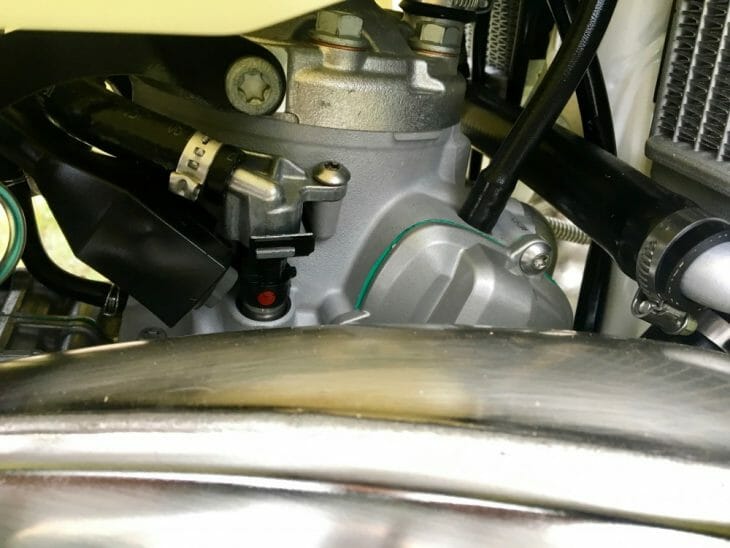
How is the “jetting” on a fuel-injected two-stroke enduro bike?
The “fueling” is spot-on. The 2018 Husqvarna TE250i is nearly perfect in putting gas and oil in an engine.
The only times this bike didn’t act as if it were perfectly “jetted” was once in a parking lot, once when the e-start wouldn’t fire the bike at camp (kick-starter did it) and once more after about a four-mile downhill of single track. In all instances, the bike acted like it was running out of fuel. Not bogging from a rich condition or wheezing from being too lean, but quite literally as if I forgot to turn the gas on, which I did not because you can’t turn the gas on or off (thank goodness) since there is no petcock. The culprit? Likely a fuel filter upstream from the injector getting temporarily plugged up. I’m blaming a journalist or guide or celebrity who rode this bike at the global launch in Canada.
Let’s blame this guy. He was there.

In all cases, the problem resolved itself shortly after a brief rest and the roosting commenced.
Overall, the jetting spec (or efi tune or computer-brain-powered fuel and air mixture stuff) feels on the lean side. The tech specs say it averages an equivalent of 80:1 or so mix of fuel and oil in the engine. And that’s pretty lean. But the power delivery itself feels like the motor wants a little more gas to start barking. It has a low-compression lean character that equates to power that is insanely smooth without snap.
Again, it’s important to emphasize how perfect the bike runs nearly always. I started it with one hand via the e-start button at 8500 feet in 36-degrees (F). It started right up and idled cleanly and smoothly. I could have ridden away from the cabin for about 70 miles and had the same, consistent fueling.
I wisely went inside for pancakes instead.
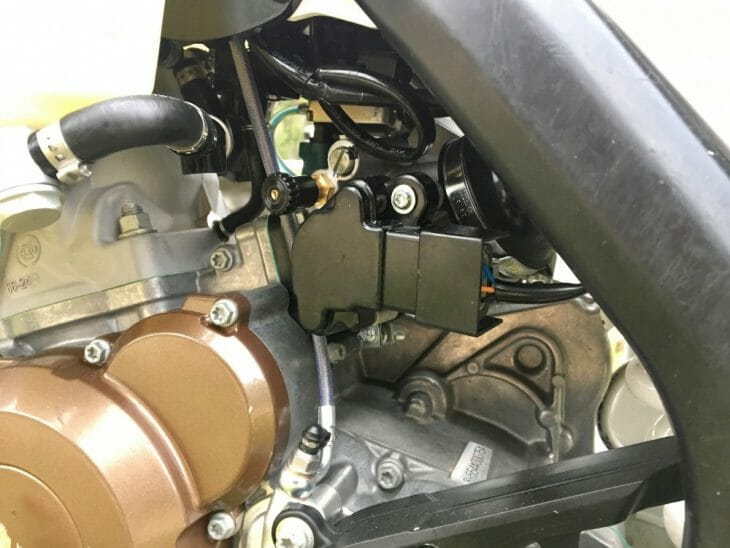
How does the fuel-injected two stroke work at high altitude?
I rode it at about 1000 feet to nearly 11,000 feet with the exact same person on the seat. And the air/oil/fuel calibration felt exactly the same at every altitude. Sure, there was a noticeable power drop above 8000 feet. But it was singing a clean tune next to other bikes whose carburetors had overreached their settings range. This bike does not overreach its setting range. It has an infinite fuel mixture settings range as far as we can tell. There is no residue on the tailpipe when riding this bike—usually a telltale sign of high-country riding where rich conditions creep in. And the bike doesn’t sputter or gargle. It just goes, “Brrrrrrraaaaaaaaaaaaaaap…” as smooth as you can say that to yourself.
Also, I didn’t ride alone. I rode with friends and colleagues who have well set-up machines for the country we were in. And most of those machines are 300cc two-strokes with standard carburetors running well at the altitudes and speeds we were enjoying. The carbs have modified jet kits but nothing crazy. All but one of the 300s exhibited an out-of-range condition (rich) at some point. I even rode with one Lectron carb on a 300cc machine that clearly was out of its adjustment range above 9500 feet or so. This is not surprising, as all of these systems require a setting that has a finite range. What is surprising is you immediately forget about that variable when you ride this bike for about 10 miles.
Poof! Like off-idle bogs and finicky FCR carb fuel screws on four-strokes, poor carburetion is a thought of the two-stroke past.
How is the fuel range with this fuel-injected two-stroke Husqvarna?
Most of the aforementioned bikes of our posse had loops or other deterrents in their carb vent/overflow tubes to prevent fuel waste in the case of a tip-over. And, as stated, they were really well jetted for the most part. Heck, one 300 was likely waaaaaay too lean but it kept working so more power to it! With my Husky completely stock with a tank full of straight gas (2018 Husqvarna TE250i fuel capacity is 9.25 liters or 2.44 gallons), I experienced the same fuel mileage as the group, in general. So, I’m not sure there’s going to be massive fuel savings or extended range advantage here with stock fuel capacity. If there is a measurable difference to be found, we’ll have to conduct testing in a more controlled environment—like a place with a gas station or electricity. But the eyeball on the fuel tank and the numbers on the odometer (confirmed by our Rever app) show the same fuel range/efficiency as a really well-tuned (lean) 300 that doesn’t leak gas every time it goes on the side stand.
More impressive than efficient fuel use on this bike is the minimal consumption of oil it devours. There is a 0.7-liter tank sneakily placed under the frame on top of the engine that holds the two-stroke mix (which Husqvarna specs a special Bel-Ray product). From there, a pump meters it into the engine according to data provided by the EMS (Engine Management System). Apparently, the EMS is frugal and likes to hang on to oil. The tank is reportedly able to last through five tanks of fuel. Well, we believe it–possibly more. It’s barely going down after multiple tanks and plenty of variation to our riding.
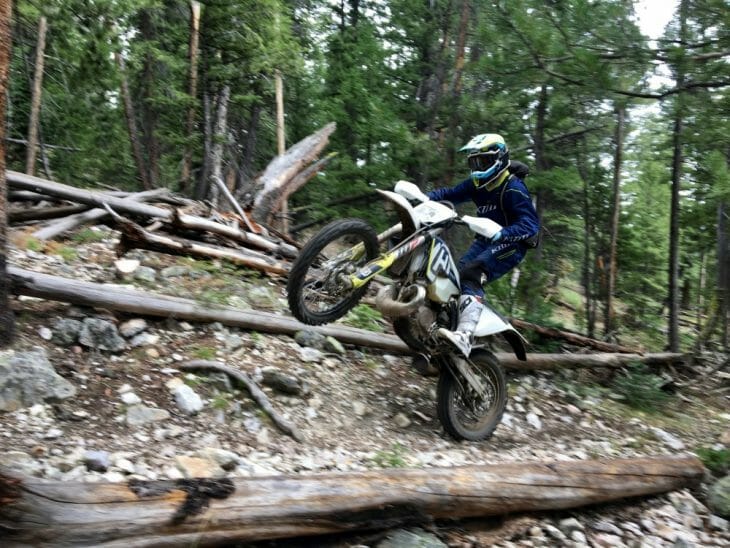
Would the Husqvarna TE250i be a good race bike?
Yes. At least I think so. It’s definitely race-worthy and the top-end rev is great in stock form. For me, this bike will be more race worthy when it gets closer to the power characteristics of a XC-class KTM—more snap and elevated power throughout with similar over-rev. So, to say I’m eager to get the power-valve tuning started is a massive understatement. In stock form, this is a trail bike character. And that includes the suspension world.
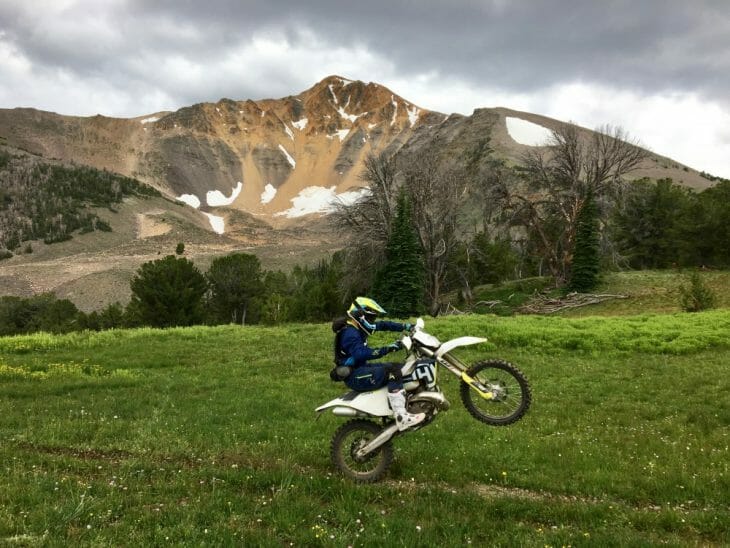
How’s the suspension?
This is a fake question because not a single person asked me about the bike’s performance other than questions about engine character and fuel-injection stuff. But for your sake, I’ll tell you that this version of the Xplor 48 fork on the front of this machine is really great. I love the ease-of-adjustment for compression and rebound changes and the external preload adjustment is great. And it works. I cranked it up to get more hold-up in the fork (I ate a lot of gas-station donuts on the road) and the difference was instant. It’s a pretty soft bike overall—built for going over obstacles with traction in mind. If you want more race, go for a re-valve and custom setup. That works, too. Out back, the WP DCC shock with linkage (Husqvarna’s have linkage on these bikes—remember that) is similarly nice. It seems well suited to the chassis and I didn’t have much to complain about there. I did hit the linkage on stuff, which would have made me feel bad, but I was too busy feeling fuel-injection, which makes me feel good.
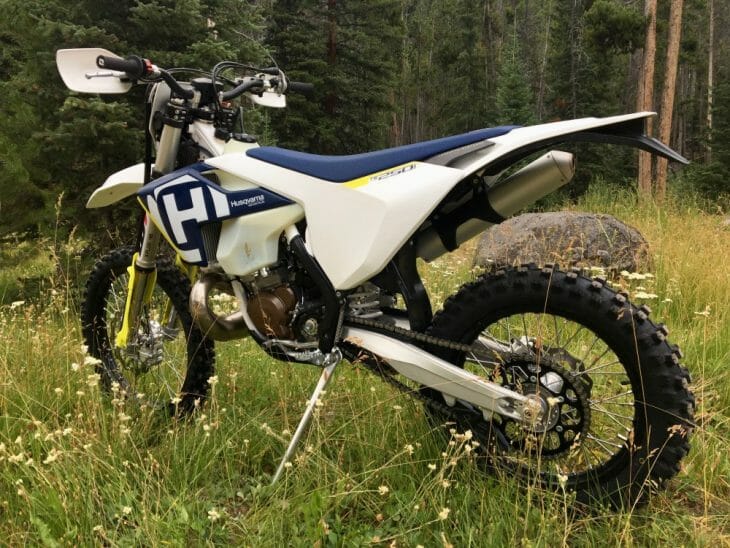
How does all the other stuff work?
Again, nobody asked this but it’s worth pointing out a few more things that I noticed while hanging out with this bike. First, the brakes are really nice. And they’re different than the Brembos you’re used to. The Husqvarna TE250i comes with Magura binders front and rear. While this is a nice differentiation to the orange cousins of Husqvarna, the performance is well worth the brand swap. The TE250i has 260mm front and 220mm rear rotors and both calipers (two-piston front and single-piston rear) give excellent feel and stopping power.
Did you know these bikes’ footpegs are higher than MX models? It’s true. These pegs are 6mm taller and the result is a slightly tighter riding position with benefits of increased ground clearance. However, I felt the bike reacts to foot input much faster when standing than the MX-chassis bikes. Pretty cool, unless you’re super tall. Then the ergos will be slightly annoying.
What don’t you like about the 2018 Husqvarna TE250i?
Well, the pipe didn’t exactly mate to the cylinder like it should when I received the bike. So, I didn’t like that. And for Rocky Mountain terrain, I’d pick a different tire than the Dunlop AT81. Also, I can’t wait to tune the power to get a bit more bark out of the 250 without killing over-rev.
Or, maybe I just want it to be a 300. For that, I suppose I’ll have to wait.
Since it has a throttle body controlling air into the engine, there is a dual-cable throttle assembly. Which is just weird on a two-stroke. The extra drag of the spring inside the throttle body is more than a slippery carb slide, for sure. It’s more of a showroom bounce sort of annoyance than a real performance bugaboo, but I’m looking for things to complain about here.
Lastly, the kill switch, which used to be a simple button forever on most dirt bikes, is now a switch. And the bike will crank over with the electric start for a really long time–at least as long as a battery charge lasts–without starting if you leave the switch in the off position. So, you have to remember to always switch the switch. I don’t know what happens if you leave it on all the time, but I’m guessing you’ll have a 2018 Husqvarna TE250i – the envy of the neighborhood – with a dead battery, eventually.
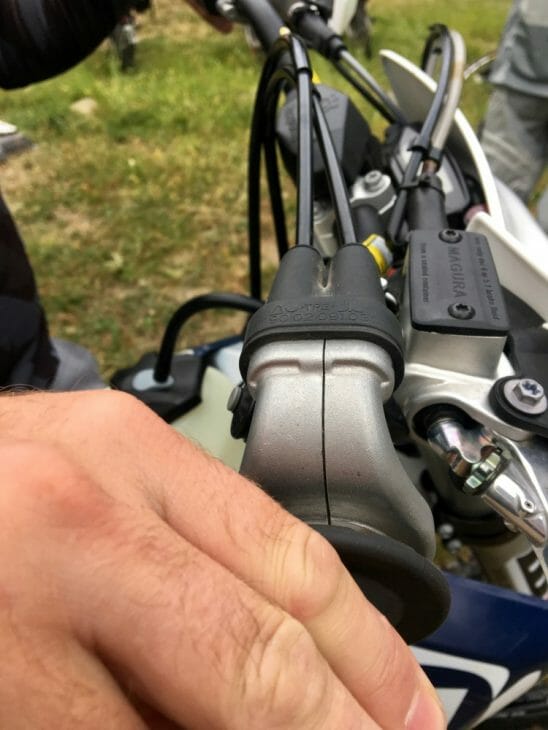
Much more on the way as Cycle News tunes up the 2018 Husqvarna TE250i a bit and tells you more stories about how the fuel-injection works inside these awesome new machines. Feel free to ask questions in the comments below. I love answering them about this bike. It’s so much fun!
Photos: Jesse Ziegler and Stephen Clark